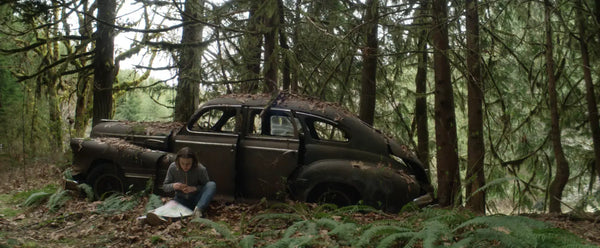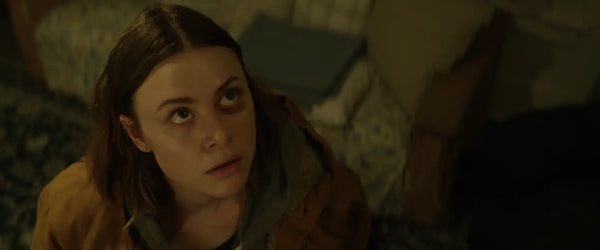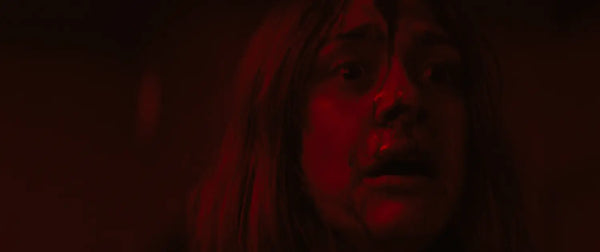The steady and thrilling story of a traumatized woman on the run and the anguished professional chasing after her, New Life is the latest in a treasured tradition of movies that make familiar genre thrills feel fresh. John Rosman, who makes his feature directorial debut with the film, demonstrates a clear understanding that character comes first when telling an engaging story, and that even in our current age of instant access and overexposure, you can still manage to surprise and entertain audiences on multiple levels.
Hayley Erin plays Jessica, someone desperately fleeing towards the Canadian border. She’s introduced to us covered in blood and sporting a black eye, but Rosman’s film leaves us to draw our own conclusions, much like everyone Jessica meets on her way. Sonya Walger plays Elsa, a trusted fixer from a nameless agency that’s in hot pursuit of the mysterious young woman, but who is dealing with physical and mental demons of her own.
New Life immediately draws you in by giving its attention to both women in full, blurring the usually simple lines between protagonist and antagonist that you see from movies. Both characters complement one another as do their individual stories, despite the two never really meeting until the film’s end.

It’s a double narrative thread that’s just as compelling as the central mystery of what Jessica is running from in the first place and why Elsa is after her. Rosman shines as a filmmaker and storyteller here as well, launching his film as a modern cat and mouse thriller before - SPOILER ALERT - the truth is revealed that New Life has full blown horror ambitions and isn’t afraid to get mean and gory.
It’s a genuine surprise among several in the story, and it's all the more impactful thanks to the slowburn, character study pace and mood that Rosman goes for with his debut. Elevated even further by two brilliant central performances from Erin and Walger, New Life sets itself above other genre fluff with the sharp, layered, and subtle filmmaking on display - all while still delivering on the kind of horror thrills that one stumbling upon it may expect.
We sat down with Rosman just ahead of the wide release of New Life, where the director discussed his inspirations and love for horror movies since childhood, as well as the challenges of creating suspenseful and surprising low-budget thrillers that balance genre elements with character-driven storytelling.

You’ve worn a lot of different hats throughout your career. What made you want to take this leap into making a feature length genre thriller like this?
John Rosman: I fell in love with film in college when I took my first editing class. Before that, I did a lot of writing, I played music, I drew, and editing was this thing that took in all these things together and you're able to create a piece of what felt like this maximalist art form. I always wanted to make a movie and nine years ago I got pretty serious about it and tried to make it a goal. So I started doing music videos and short films, and then I was doing live documentary work in journalism. I went freelance doing more commercial shoots, but it was always towards this goal of making a film. And I've loved horror movies my entire life. I think I saw my first horror movie in first grade, unfortunately for everyone in my family. So I think it was always going to be a horror movie.
Are there any other slow burn films similar to yours that you took inspiration from?
John Rosman: Repulsion is one I've talked about a little bit. It’s really cool, it’s a Roman Polanski apartment film, you're following a young woman and you're with her and she just kind of seems lost. But by the end of the film, you're like, “Oh, my God, who is this person I was with this entire time?” I was like, putting my whole psyche on this person and all her actions. I think The Vanishing is another one. It's just this incredible slow burn film. You’re with these characters and before you know it's like this insidious thing that ramps up. The ending is one of the most haunting images in film.
I really love films like Michael Clayton. You know, adult potboiler films. I really like new character study films like Chloé Zhao’s The Rider and Wendy and Lucy by Kelly Reichardt. It is a challenging film, right? Because when it opens it’s like this indie character piece film, so someone who's coming for a horror movie is gonna be like, “What am I watching?” and then it ramps up by the end. But I trust viewers, and the hope is that if they're patient and they stick with it enough, they have a relationship with the characters. So once the things start to really go off the rails, you have a completely different set of stakes with those characters.
Was there ever any temptation while marketing this movie to give away its horror surprises?
John Rosman: It’s tricky. We all watch and consume so much content now that I think the best version of this film is going in cold and just being completely surprised. I think the audience is totally there right now because audiences want to be surprised. The thing is, you gotta get people to click on said movie, right? You have a movie to sell. We had people who wanted to buy the film and they all had their different pitches for it. Some were like, “We’ve got to lean in and just sell it as a zombie movie”. And to me, if someone came in expecting that movie, they would hate it because it doesn't meet that expectation. So our partner Brainstorm Media really saw this as a thriller that has some horrific elements to it, and I think that's a smart way to pitch this movie and think about this movie. If you come in for a thriller, I think you're in a different kind of headspace versus, like, World War Z. I love that movie, but they're very different films.

This is a great example of a movie that’s doing more with less. Did you try to apply that mentality while making New Life?
John Rosman: A lot of my work doing music videos, you’d get like 500 bucks even if it was for some major label or whatever. So you have to learn how to do more with less and surround yourself with really smart crew and producers. Then it becomes this big puzzle, right? Where you're like, “Okay, we have this amount of money, and this script is insanely ambitious, so how can you do it?” A really great example of this for New Life is there's a scene of just leaving town outside in the woods, there’s this couple who have a farmhouse with a barn, there's this bartender we meet in Canada and we're in her house where there's kind of a big fight scene. That's all one location. We just separated what you see in the house for different parts of the film. Our production designer, Jade Harris, was like, Okay, this is easy. We'll just stay in the kitchen, and we'll shoot in the backyard towards the farmhouse. We get some pickup shots, and then I'll set dress on the other side of the door a different house that could still play as being from up north. So that's a way where it's like, yes, you have to pay for a location, but in that location we're getting about seven days of our script filming here.
What do you think changed the most from the inception of this movie and story to how it ended up being once it was finished?
John Rosman: I love horror movies because they're like a roller coaster ride. You're buying a ticket to get a certain experience. You can be challenging, but I feel like really challenging horror movies never really do great because they kind of lose their factor. It should always be entertaining. That's why I think the best filmmakers come from genre backgrounds, because they know that at the end of the day you want to entertain an audience. So my golden rule was this needs to still be entertaining. We're talking about heavy stuff, but I still want to make a compelling thriller and a compelling horror movie that feels like a horror movie. So in earlier drafts, there were crazier fight scenes, crazier chase scenes, all these things. Once you’re working with the actors filming during the day, cutting down, thinking for budget, it was that balancing act of still keeping that horror film, but not being afraid to still make it an intimate character piece. Finding that dance where it can still feel small and intimate but be entertaining. That was the real big challenge of this film that we were trying to tackle.
How did you decide on how you wanted to portray the horror elements of this story and the physicality of people who were infected?
John Rosman: I wanted these people to kind of be aware that they're infected and be these weird personifications of what both of the main characters go through. So they're kind of aware, they're in this fog of confusion, but they’re still threats and it can still spread. I think that's also what's fun about horror movies is you can say, Okay, we’re in the genre boundaries, we kind of know the rules here. If you're taken down by this person, you're gonna spread it and blah, blah. But because of that you can have fun with it and create these stories around it and some mythology around it. I think what was unique about ours was we wanted the monsters to feel a little bit aware, in pain and confused.
Our lead casting director, Emily Schweber, was really central in helping get our leads, Sonya Walger, Hayler Erin, and Tony Amendola. Then we relied on simon max hill casting in Oregon for a lot of local casting. Something that I wanted to cast for was finding people who fit these roles, but then always making them show us their monster. Someone can be really incredible on this emotional level, but then their monster is kinda off. I was working with Simon and his team and the three of us were navigating that with the actors, asking them to be a little more inward, as if it was tortured, and all these things. Then the performances started getting better and started tying closer to the characters that they’re playing beforehand. It was an organic process.
What surprised you the most while you were shooting New Life and how it’s been seeing reactions to it now that the film is finally out?
John Rosman: I think during making it, you will be surprised how dependent you are on the weather. The last scene is this person on the run and they're trying to get to Canada. There's these mountains in the distance, they're almost there, are they going to reach it? We picked the location out, woke up in the morning, and there's fog right up to your face. This whole production is so to the bone. You can't lose a day. When the clouds slowly started clearing no one was allowed to say anything out loud about the weather. If anyone even looked at the sky, there’s heavy tsking.
What was really surprising when I released it was I was so close to this film that I totally forgot there's a twist in it. I think it was really surprising how close and in depth you can get. You spend a year on something and you just kind of lose the bigger picture. You're so focused on the hyper nuance of it. Releasing it in the world, it takes on this different life. Which is really cool, because then you're seeing it through other people's eyes and you're reminded of the big picture.
‘New Life’ is now playing in select theaters and is available on demand.



